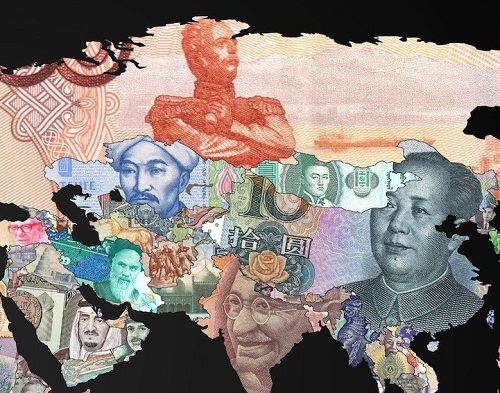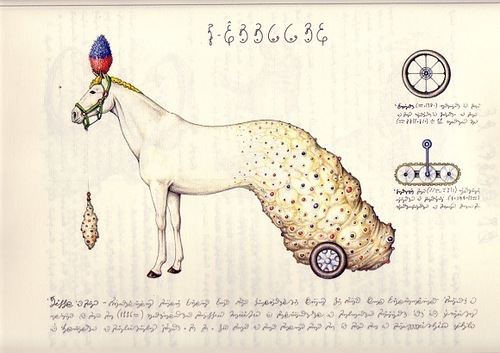World antique and bizarre maps
World antique and bizarre maps feature terrible monsters, swallowing ships, and mysterious signs, like the bounds of storms and dangerous currents. However, many people like antique maps, with sea serpents and hideous monsters in the vast expanses of the ocean. Meanwhile, any ancient map shows how the world looked in the distant and not so distant past.
The southern part of the world were the last parts displayed on the map by Europeans at the time of the great geographical discoveries. But the idea of ”Terra Australis” appeared in the days of Aristotle in the 4th century BC. However, many different theories arose over the centuries: in the south Indian Ocean, separated by land, the land of the northern hemisphere must be balanced by land in the southern hemisphere, Africa stretches up to the South Pole. In 1820, Antarctica was finally discovered in the area, which had always been associated with Australia. Here is a map of 1587.
In the same spirit, the map of the world in 1964 based on the novel “Fatherland” (Fatherland), the idea of which is to assume that Germany was defeated in World War II. III Reich marked in red, the European Union, which is a Nazi allies and conquered nation – brown colonies – orange, holding U.S. and allies – in blue, and neutral countries – Yellow.

Planisphere Contino 1502 is the earliest survived map showing the opening of the Portuguese sailors in the west and east
Considered the earliest map of America (except map entitled “Certificate of Birth of America”) shows a part of the Caribbean islands and the coast of Florida, as well as Africa, Europe and Asia to the coast of Brazil, opened a few years earlier.

the map of the world in 1964 based on the novel “Fatherland” (Fatherland), the idea of which is to assume that Germany was defeated in World War II
Alternative History on hypothetical maps. Genre of alternate history has generated a certain part of hypothetical maps. The following maps reflect what could be Europe if German won victory in 1940.
A map drawn on the novel by George Orwell’s “1984” Area on the map marked as controversial and lead to perpetual state of conflict between the various power blocks, reminiscent of Cold War tensions in Africa and Asia between the superpowers.
In the 70s C. Etzel Pearcy, geography teacher, proposed to revise the boundaries of the U.S. states. According to his theory, the country should be composed of 38 states with new names, which is an area that differ from each other culturally and physically. Naturally, this idea was not implemented, but it is very interesting.

Another idea of revising the boundaries of the United States took place in the campaign of vodka ‘Absolute’, which was held in Mexico and caused a great resonance
Meanwhile, in the United States observed the calls to boycott the Swedish vodka. Still, the map has some basis in reality because Mexico lost the territory of Upper California and New Mexico during the Mexican-American War, 1846-1848. Mexico lost 42% of its territory, which later became the states of California, Nevada and Utah, and part of Arizona, Colorado, New Mexico and Wyoming. The company “Absolut” apologized, saying that advertising aimed the Mexican market, and did not mean that the company was anti-immigrant, or anti-American, and did not require revision of borders, etc.
Most students of history departments are familiar with the map of Africa, dominated by European powers on the eve of the First World War. In fact, after 1918 Britain and France divided German colonies, and Africa remained under foreign control for decades. However, only Ethiopia and Liberia, created as the home of freed slaves in the 19th century remained independent.

the British Empire in 1920 after the accession of the German colonies in Africa and the division of the former Turkish territories in the Middle East between Britain and France. Antique and bizarre maps
These days it is difficult to imagine that a small country like Britain, once owned a quarter of the world, including huge populations, such as in India. And here is the British Empire in 1920 after the accession of the German colonies in Africa and the division of the former Turkish territories in the Middle East between Britain and France.
And some similar map of the late 19th – early 20th centuries. First of all, it was the Asian vision of the world situation at the time of the Chinese Revolution of 1912. Published in Japan, it reflects the many foreign influences on China at the time. During this period, before the start of World War II, the “Russian Bear” is a threat to all of Europe and Asia. Besides, Britain represented by a sea monster, thus reflecting the country’s position as a naval power, dominant at the time. And Germany is as fanged warthog.
Meanwhile, this satirical map of Europe dates back to 1870 and reflects the political situation of the day. England invaded Ireland, which depicts an angry dog on a leash, but France is struggling with Prussia.
In addition, the so-called octopus map appeared several years later. At the time, the Russian Empire looked as highly expansionary: it spread its tentacles to Turkey and Persia. But, at the time, held back by Germany.
Although the map of 1539 may seem incomplete, according to modern standards, but shooting from the satellite have shown that the sea monsters depicted in some parts of the ocean on the map correspond to well known storm fronts, currents and other marine hazards. So, it was a warning sign for the sailors of the time, dared to swim in those places.
World antique and bizarre maps
- A fragment of a decorative map of the world with Antarctica and North America, which was released in Amsterdam in 1689
- Decorative map of the world with Antarctica and North America, which was released in Amsterdam in 1689
- Italian map of North America in 1566 is one of the first maps that display the most northern parts, such as Canada
- What could be Europe if German won victory in 1940
- Mexico in 1824 with the territory, later given back to the United States
- England by Robert Dayton, 1795
- “Humorous Diplomatic Atlas of Europe and Asia” by Kisaburo Ohara (Japan), 1904
- The weird map showing even more aggressive Russian octopus, was created in Japan during the Russian-Japanese War of 1905
- “Hand of Moscow” map
- Very impressive political map of the “Land and magical kingdoms of the Rings”
- Incredible in its philosophical depth “Map of humanity”
- The bizarre post-war map of the world (for a new global order)
- “Upside-down” map where the north is at the bottom
- “inverted” map, even more unusual, where the land is shown in place of the ocean and vice versa
World antique and bizarre maps
- Map of 1587. 1587 Map. The mythical continent, occupying a vast part of the southern hemisphere
- Jerusalem in the center, “Guide to the Scriptures” (Itinerarium Sacrea Scripturea) Henry Bunting, 1545-1606
- Poseidon map, about 150-130 BC
- Ptolemy’s view of the world, published 10 years before the first voyage of Columbus
- Planisphere Contino 1502
- Detail: the coast of Brazil (left), the Persian Gulf (right)
- Pietro Kopp 1502 map, one of the last maps that show so-called “Dragon’s Tail”, coming from Asia and based on the idea of Ptolemy, who has 1500 years ago believed that the Indian Ocean is surrounded by land
- Venice map shows most of the buildings of 1565. The maps in this style is still quite common in tourist postcards and in guidebooks of the city
- Richly Map Marina (Carta Marina), 1539
- monsters in the seas around Iceland in the early 16th century
- Pre-historic animals
- Fish Curious Detail of antique map
- Amazing creatures – details of ancient maps
- Sea monster
- inhabitants of the ancient seas and imagination of seafarers
- The whale island, printed in Novi Orbis Indiae Occidentals in 1621
- Upside-down map where the north is at the bottom
- 1587 map
liveinternet.ru/users/nomad1962













































